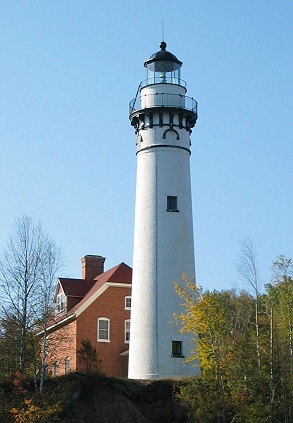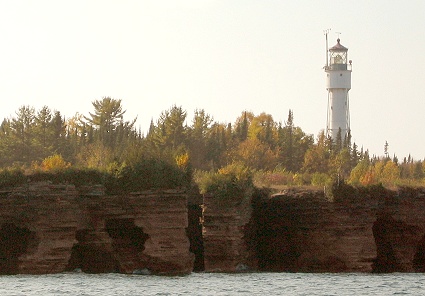| |
Lighthouses of the Apostle Islands
Part Two
Back to Part One
The three earliest lights had all been sited to guide ships through
the Apostle Islands, but in the years after the Civil War, more and
more captains set their courses to bypass the archipelago completely.
The decade of the 1870s saw the emergence of Duluth as a major shipping
center; now lights were needed on the outer ring of islands, to guide
sailors heading further west.

Outer
Island Lighthouse
|
In 1874, the first of this new group was built, appropriately enough,
on Outer Island. The conical brick tower was far grander in scale than
its predecessors: taller, with a more powerful lamp. Within its first
weeks of operation, the light station felt Lake Superior’s full fury.
Storm waves washed away the dock, and a section of the bluff collapsed,
nearly destroying the fog signal building. Keeper O.K. Hall recorded,
“The gale last night made
the tower shake.” The vibration was so strong that he feared the lighting
apparatus would break. Two nights later, the temperature plunged, and
he noted, “Our oil congealed so that it would not burn.”
As if the physical hardships were not difficult enough, Hall found that
his assistant, John Drouillard, posed an even greater challenge. The two
men quickly came to despise each other. “I have lived in a perfect hell
all winter,” Hall complained. “He abuses me with the most profane language
a man can utter, from no cause or provocation, and threatened to give
me a thrashing. I caught him asleep on his watch and since then, he has
lived in one part of the house and I in the other.” The stalemate was
not resolved until Hall received permission to fire Drouillard.
If the early years of the Outer Island station demonstrate how bad
life can be when lighthouse occupants don’t get along, the reminiscences
of a later keeper show a brighter side to island life. "It was like
home out there,” recalled Vern Barningham, who tended the light in the
1940s. “It was cool and nice and quiet. All four families got along together.
All the wives got along swell."
Two more lighthouses followed Outer Island on the extremities of the
archipelago: Sand Island at the western edge of the chain, and Devils
Island, on Wisconsin’s northernmost patch of ground. The small Sand Island
light was built from stone quarried right on-site; the Victorian Gothic
structure is a perennial favorite among lighthouse fans. The austere iron
cylinder at Devils Island, by contrast, has been likened to a missile
ready for launch, but its setting overlooking the island’s sea caves can’t
be beat for dramatic beauty.

Devils
Island Lighthouse |
We know a great deal about daily life at the Sand Island lighthouse
through the writings of a keeper’s wife. In 1895, Ella Luick arrived on
the island as a teenaged bride. Keeper Emmanuel Luick was happy to let
his young wife help with paperwork, and Ella used the station logbook
as a personal diary. Its pages record her pleasure in picking strawberries
and blackberries, her frustration with flies that sometimes became “terrible
bad,” her anger at the hawk that ate her chickens. The logbook tells of
one frightening day, when, alone at the lighthouse, she caught a finger
in her sewing machine, piercing it through. “It was not very painful,”
she reported, “but I fainted twice from nervousness.”
Ella Luick was neither delicate nor helpless. The log records numerous
occasions when she stayed on the island to run the light while Emmanuel
made overnight supply trips to the mainland. Late in the 1901 season,
when the keeper fell seriously ill, she took over his duties for nearly
three weeks, tending the lamp each night and caring for the station during
the day, all while looking after her sick husband. Then, as the shipping
season came to an end, she wrote proudly in the log, “Mrs. Luick inspected
the Station. Everything in order for the winter.”
Serving as de facto assistant keeper was not unusual for a lighthouse
wife. One observer commented, "I know of no other branch of the
government in which the wife plays such an important part." While
running homes and caring for children under arduous conditions, many lighthouse
women also took turns filling lamps, trimming wicks, and watching the
flame through the night. Occasionally, the Lighthouse Service recognized
the worth of the wives’ labor and granted them the title of Assistant
Keeper, with salary to match. Among the women so designated were Anna
Larson and Mary Snow at Raspberry Island, and Matilda Rumrill at Michigan
Island. More typically, however, keeper’s wives received no pay for their
work.

Ella and
Emmanuel Luick
|
Resourceful as she was, Ella Luick could not overcome loneliness and
boredom. One Independence Day she celebrated, “firing off some fire crackers
and torpedoes and having as good a time as was possible,” then lamented
that the day was, “A very poor imitation of a Fourth.”
At the end of the 1898 season, impatient for the boat that would
take her to the couple’s winter home, she complained, “I haven't anything
whatever to do and time goes slowly.” Two days later, still waiting, she
added, “Mr. Luick hasn't anything to do, so he can help me do nothing.”
Ten years as a keeper’s wife was enough for Ella Luick. On May 19, 1905,
a log entry in her husband’s hand says simply, “Mrs. Ella Luick left for
Bayfield on Steamer Barker at 6 PM.”
She never returned to the island, or her husband, again.
Emmanuel Luick married
again several years later, and had four children with his second wife.
One was born at the lighthouse, with only the father to attend the delivery;
another died on the island, taken ill during a storm that kept medical
aid out of reach. The Luicks were not alone in either their joy or sorrow:
several births were recorded at the lighthouses over the years, and several
deaths as well.
If lighthouse life could be tough on grownups, children seemed
to thrive in the island environment. The recollections of keeper’s sons
and daughters often echo the words of Grant Kirkendall, whose father served
at Michigan Island: “There always seemed to be things to do... Playing
pirate, frontier scout, swimming, hunting agates, or just walking through
the woods or along the beach. Although there might not be other children
around, if you had an active imagination, you were never alone.”
Typically, wives and children would leave the islands when school began
on the mainland. The most trying times for keepers would start soon, as
autumn storms gave way to winter. Occasionally a keeper would stay on
the island after navigation shut down, but usually Lighthouse Service
tenders like the Marigold and the Amaranth would pick them
up just before the ice closed in. In December 1918, the lake froze so
quickly that no boat could get through in time to relieve the stations,
and the Devils Island keepers were forced to walk eighteen miles across
the windswept ice to reach the mainland.
Continue to Part Three
|
|